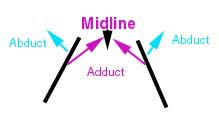
Extend - a motion that increases the angle between two bones. An example of an extensor is the triceps brachii.
Hinge Joints

Flexion of the shoulder results in a movement of the limb posteriorly and flexion of the hip results in movement of the limb anteriorly.
Retract - a motion that moves a bone parallel to the longitudinal axis and in a posterior direction.
Ball & Socket Joints

Abduct - Moving a skeletal element away from the ventral midline.